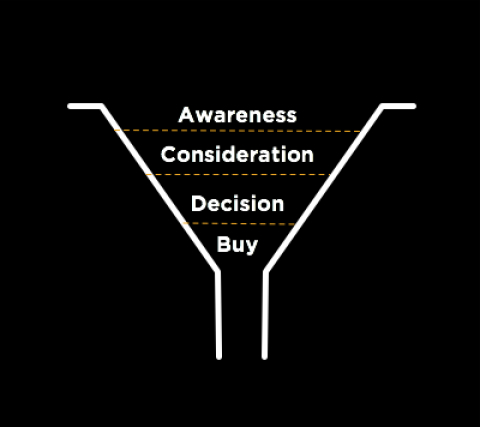Image: In your face, conventions!These are the notes from my talk at the Challenging Conventions event from the Digital Marketing event in London this evening. Slides are on SlideShare and at the foot of this post. The theme for this evening is challenging conventions. So I’ve taken that to heart, starting by challenging the status quo in marketing and seem to have ended up challenging everything I do as a marketer as well.
It is good to do this, though. Scary though it is, holding ourselves to account keeps lazy thinking and bad habits at bay.
An age of reason?There are two conventions I would like to challenge, and to encourage you to challenge, this evening.The first is that we live in a rational age.The second is that advertising and paid media is the beating heart of marketing, the mainstay of the way a brand communicates.I’d just talk about the first if I could, but this is a digital marketing event, I’m from a digital marketing business and we need to ground this stuff in our reality, don’t we?
Reading the excellent
This Will Make You Smarter has made me think about how unscientific and irrational much of modern life can be. We live, act and make decisions in crazy ways – ignoring evidence in decision-making, not bothering to gather data, entertaining political and media debates based on populist, groundless nonsense and anecdotal evidence (which is often worse than having no evidence at all, it seems).
When did it become a good idea to see a doctor?We had witch doctors and wise women and shamen to run to when we were ill for thousands of years. Then, as science began to emerge, we got physicians, they formed professional associations – the
BMA was founded in 1832.So in what year did going to see one of these professionals make it more likely that you would live than die? Anyone?The estimate by epidemiologists cited by Evolutionary Psychology pioneer
John Tooby in aforementioned This Will Make You Smarter is 1905. Before then, going to see a doctor might actually have meant you were more likely to die or get worse than be healed. The famous researcher
Ignaz Semelweiss noted that the mortality rate of women in childbirth in the mid-19th century doubled when doctors were present.Yikes!
You might as well have visited a witch doctorAnd while seeing a doctor these days is a very good idea indeed if you are ill (most of the time) we still seem to have our share of snake oil salesmen and quacks about.When we think of the money and resource and training and trust that society lavished upon financial markets experts – economists, regulators, commentators, treasury officials, commentators and analysts – did any of them help us avoid a catastrophe in 2008?We’re still happy to trust experts. And technology and science can often become nothing more than shiny gonks, totems and lucky charms waved about to impress us. Comfort us. That someone knows what’s going on.It isn’t a lack of integrity that gets in their way. These guys believe in themselves. Their faith, held up with some totems let’s them get away with it.The difference between the doctors who got it right and the doctors who got it wrong, the doctor of 1904 who was more likely to kill you and the doctor of 1906 who was more likely to save you was slight.It would have been a combination of better knowledge, tools, methods, drugs resulting from the continued use of the scientific method and the continuing spread of ideas about sterilisation.
What about marketing?And then I think… what about my job? What about marketing? What about reputation management?
The Economist’s Schumpeter column had a good argument that for all the growth of the reputation industry and the unarguable importance of reputation itself, you were probably better off not trying to manage it but just doing better things, making better things for your customers.Is there a scientific method in what we do in marketing? Or are we incanting magic brand words and strategies and doing things we don’t really know if they work.It’s an uncomfortable thought, a challenging thought that forces us to try and account for the validity of our work.We don’t know whether the application of marketing helps or hurts a brand. We accept it as convention that it does. We focus on the success stories disproportionately and ignore the sea of failures.Actually this is probably even more true in earned media / social media than in mainstream marketing. So much is tried without a model or method behind it that Facebook is awash with brand pages that look like they wished they could make their excuses and leave the social networking party early.Perhaps it would be better if many of them did that…
A funnel thing happened? Maybe there are a couple of trends that which will make marketing a demonstrably net positive profession like doctors did in 1905.Maybe the scientific method is one of those, just like it was for them. Maybe when we start using data properly and consistently and thinking like scientists we’ll end up with better marketing. We always have the excuse of wanting to be artists as well, I suppose…But the first distortion that has skewed marketing is
the sales funnel. We all know how this works…
But its outcomes are treacherous. We over-focus on filling the funnel and give little thought to what happens to customers after they press the buy button.Advocacy, the most powerful form of marketing there is, is absent – because this is all about prospects and not about customers.A brand is a promise kept, but brand communications built around this model are only about the promise.It leads to a state where most money – 90% for many brands – lives in paid media, in advertising.This distorts all sorts of things. It is such a large imbalance in fact that you could see it as a corrupting influence. Talk to people who sell and buy media at scale about the lavish entertainment, the deals done between networks and media groups.You might say there was something wrong with this picture. Something distorted.Certainly P&G’s investors felt so when they put pressure on the company’s CEO to
account for increases in advertising spend, when SEO and social media looked under-appreciated.It skews marketing, brand communication into being a game about attention. About numbers. About quantity and reach. It separates it from value.
Spurned MediaIt was in the title that I set for this talk, so I better reference the idea of spurned media.A lady in a focus group I sat in on recently said: “If there’s a good ad on TV, someone will send me a YouTube link to it.”How many links to ads do you get sent by non-advertising friends?It is a more miss than hit affair, advertising. Some brands don’t seem to even expect it to succeed.Consumers spurn advertising messages. Ad blockers are the top plug-ins for browsers. Ad pots are skimmed. Instapaper, ReadItLater and Safari’s Reader feature various help us to see past the forest of fizzing animations and rollovers…
The dark matter of metrics Does anyone take a look at the damage that spurned media does to a brand when we persist in troubling people with it?I think of this as the dark matter of digital metrics – the missing, unseen data about what advertising does…
The correction starts at 20% So there is a market correction coming in how brands invest in talking to their customers.The opportunity to talk to customers in different ways has been there for a long time. But unexplored, under-invested in.Now pressures are coming to bear, the case for different ways of communicating becomign undeniable.Coca-Cola took a lead at the end of last year when Muhtar Kent, its CEO as well as its CMO and other marketing leaders outlined a vision for the brand beyond the age of advertising.
Coke committed to spending 20% of its marketing budget globally ($2.5 billion since you ask) on inbound media.
How to challenge the conventions of marketing So to practicalities – how do we go about challenging the marketing orthodoxy in a constructive way? These are three things I think are essential:
- Customer experience models: Models like the McKinsey consumer decision journey bring a clear method to the madness of the online media world. They ask the simple question: what does the individual want at each stage of the process of their choosing, purchasing and being a customer? In their Branding in Digital article for Harvard Business Review, McKinsey & Co’s team highlighted – with evidence and case studies – the massive imbalances in brand spend.
- Social business boldness: Social business design is more than a buzzword. It usefully described the space for radical change in customer engagement and communication taking place between marketing and the rest of the business. the business case for communicating differently with customers is a more useful place to start than the marketing case.
- Integrate earned media: The non-paid media disciplines – social media, content, SEO, PR & UX – need each other to succeed. They need to stop arguing about which is best and how one should lead the others and integrate tightly, led by earned media-first strategic planning and underpinned by data analysis.
Now is a good moment to challenge conventions in marketing. Market forces are pushing our industry toward new ways of engaging with customers.



